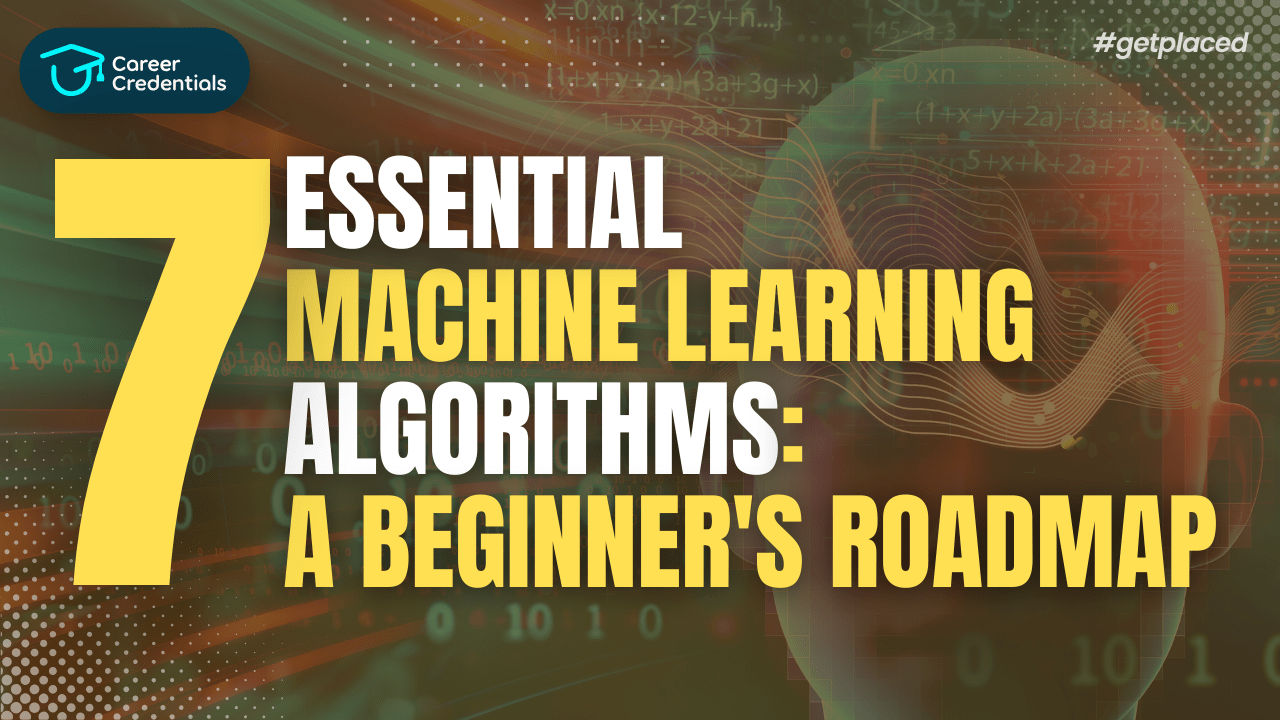7 Essential Machine Learning Algorithms: A Beginner's Roadmap

Welcome to the world of Machine Learning (ML), where algorithms power some of the most impactful innovations across various industries. From analyzing X-rays to predicting stock market trends, ML algorithms are at the heart of these advancements. According to Fortune Business Insights, the global machine learning market is set to soar from 26.03 billion USD in 2023 to a staggering 225.91 billion USD by 2030.
To navigate this exciting field, it's crucial to understand the foundational algorithms that drive ML models. In this beginner's guide, we'll explore seven essential ML algorithms that form the backbone of many applications.
Read Blog: Why Machine Learning is Crucial for Your Future Career from Expert
1. Linear Regression
Linear regression is a foundational supervised learning algorithm used for predicting values within a continuous range. Imagine forecasting sales numbers or prices — linear regression can help. Originating from statistics, this algorithm establishes a 'regression line' from labelled data, making it ideal for predictive modeling tasks.
2. Logistic Regression
Logistic regression, despite its name, is a supervised learning algorithm used for binary classification tasks. It predicts the probability of an input belonging to a particular class, making it useful for scenarios like image classification into two categories. Logistic regression is a go-to for binary categorization needs.
3. Naive Bayes
Naive Bayes algorithms are a set of supervised learning tools used for binary or multi-classification. These algorithms operate on conditional probabilities, making them adept at tasks such as classifying objects based on various factors. For instance, identifying plants based on size, color, and shape.
4. Decision Trees
Decision trees are versatile supervised learning algorithms used for both classification and predictive modeling. This algorithm, resembling a flowchart, segments data by asking questions and branching out based on answers. Decision trees excel in handling complex datasets with ease.
5. Random Forest
The random forest algorithm utilizes an ensemble of decision trees for classification and predictive tasks. By aggregating the results of multiple decision trees (often hundreds or thousands), random forests reduce overfitting, a common issue with decision trees. This makes them robust for various applications.
6. K-Nearest Neighbors (KNN)
K-Nearest Neighbors is a supervised learning algorithm used for classification and prediction. It classifies data points based on their proximity to other known data points. For instance, if a point is closer to blue points than red points on a graph, it's classified as blue. KNN is effective for both classification and prediction tasks.
7. K-Means Clustering
K-Means is an unsupervised learning algorithm used for clustering and pattern recognition. By grouping data points into clusters defined by centroids, K-Means is handy for segmentation tasks. It's especially useful for large datasets, though outliers can sometimes challenge its accuracy.
Also Read: Exploring Machine Learning: Algorithms & Applications in Python by Career Credentials
Training Machine Learning Algorithms: Four Methods
Now that we've covered these algorithms, let's dive into how machine learning models are trained:
1. Supervised Learning
Supervised learning uses labeled datasets to train algorithms, guiding them towards specific outcomes. It's like a teacher guiding students in a classroom, where the labeled data acts as the 'answer key' for the algorithm.
Must Watch: Understand What is Supervised Learning in Seconds !!
2. Unsupervised Learning
Unsupervised learning works with unlabeled data, allowing algorithms to identify patterns and structures independently. Researchers use this when they don't have a predefined outcome in mind, similar to a learner figuring out solutions without a teacher's guidance.
3. Reinforcement Learning
Reinforcement learning is akin to trial and error learning. Here, an agent attempts tasks, receives feedback, and refines its approach to achieve optimal solutions. This is similar to how a child explores and learns in a new environment.
4. Semi-Supervised Learning
Semi-supervised learning combines labeled and unlabeled data, making it useful for tasks with vast amounts of data that are challenging to label entirely. This method is like learning from both examples and exploration simultaneously.
Check Out: Python Fundamentals- Crash Course by Prashant Jha
Conclusion
These seven fundamental ML algorithms and four learning methods form the building blocks of machine learning. Whether you're predicting sales trends or classifying images, understanding these algorithms and learning methods is crucial for any aspiring machine learning enthusiast.
Embark on your ML journey with Career Credentials.
Don't let another opportunity pass you by. Invest in yourself and your future today! Click the button below to schedule a consultation and take the first step towards achieving your career goals.
Our team is ready to guide you on the best credentialing options for your aspirations.
Let's build a brighter future together!
Empower Yourself. Elevate Your Career at Career Credentials Where Education meets Ambition.



